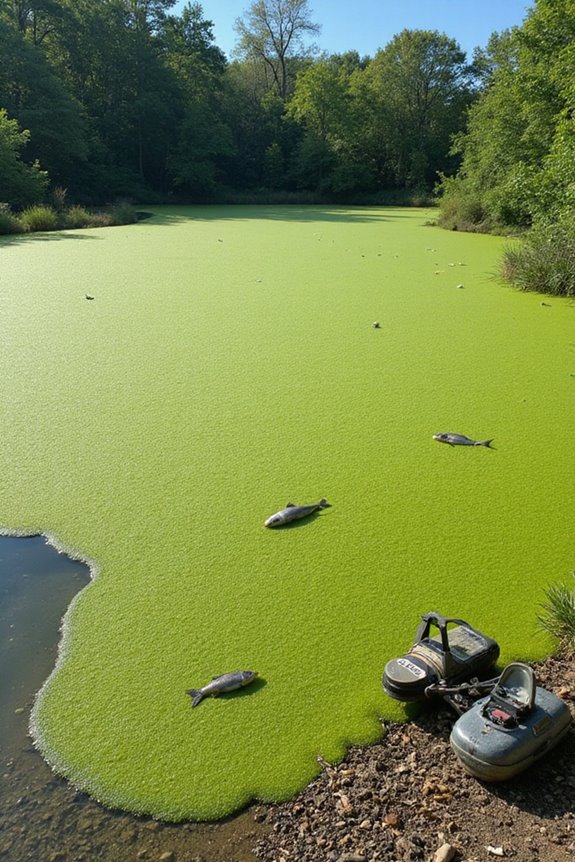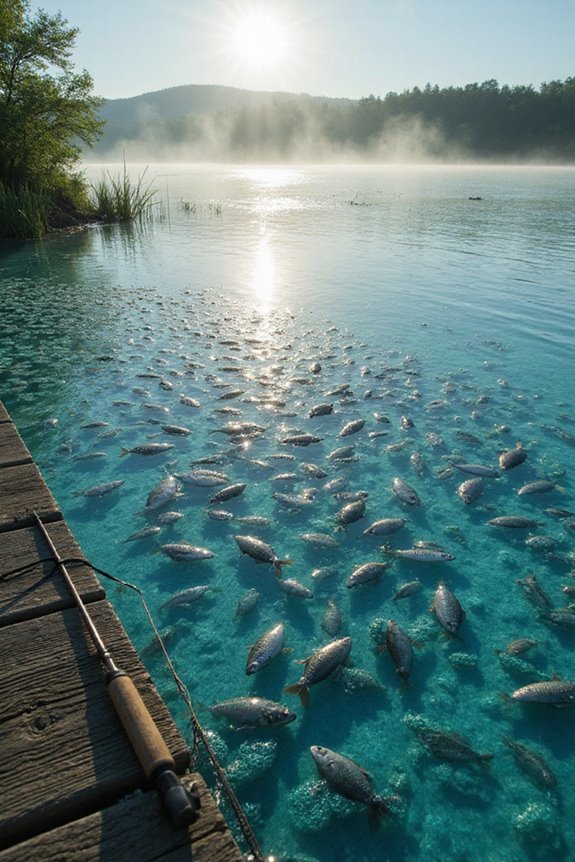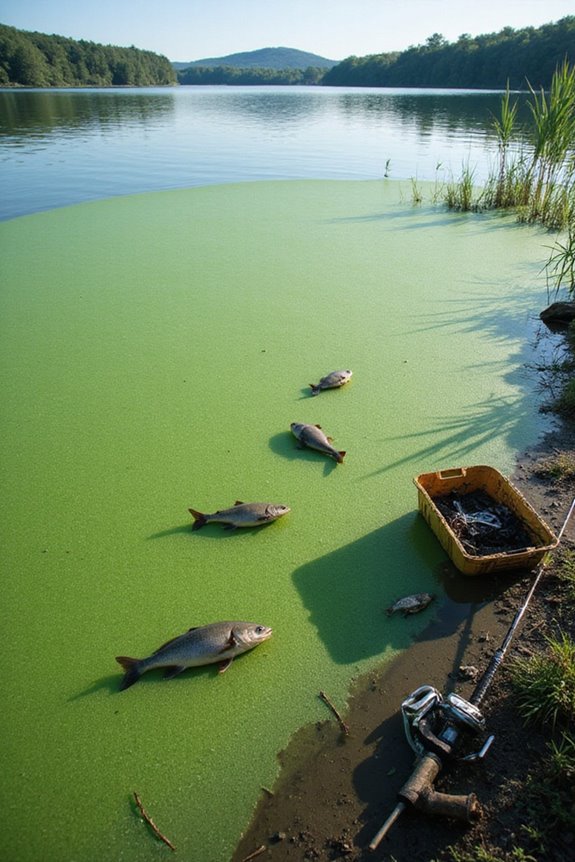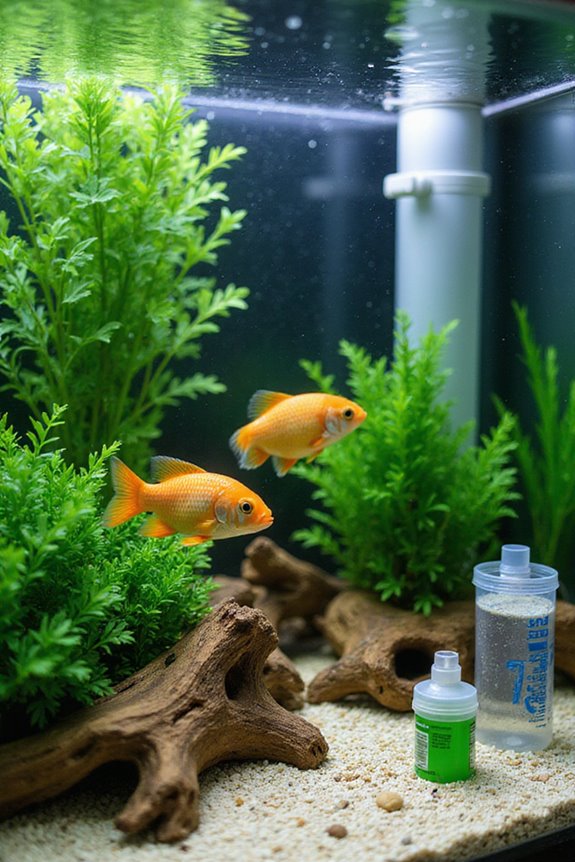Excess algae from harmful algal blooms can severely kill fish. They deplete oxygen in the water through respiration and decomposition, creating hypoxic conditions that suffocate aquatic life. Additionally, toxins released by certain algae harm fish gills, impairing oxygen uptake and causing stress. During fishing trips, especially in lakes and coastal areas affected by blooms, it’s essential to check local advisories and consider safer locations for catching fish. Stay tuned for more on the broader impacts of algal blooms.
Key Takeaways
- Excess algae from blooms deplete oxygen in the water, leading to hypoxia that can suffocate fish.
- Algal toxins damage fish gills, impairing oxygen uptake and causing physiological stress.
- Neurotoxins from harmful algae induce erratic behavior in fish, increasing their vulnerability to predators.
- Decomposing algae consume more oxygen, creating dead zones that collapse fish populations.
- Nutrient pollution from agriculture exacerbates algal blooms, threatening aquatic ecosystems and local economies.
Toxic Effects of Harmful Algal Blooms on Fish
When harmful algal blooms (HABs) occur, they can have severe consequences for fish populations. Toxic exposure to algal toxins, like those from Karenia brevis, leads to gill damage, impairing oxygen uptake. Fish with damaged gills face physiological stress, struggling to breathe even in oxygen-rich waters. Additionally, neurotoxic effects disrupt their nervous systems, causing erratic behavior and loss of coordination, which hinders predator avoidance. This makes them more vulnerable to predation. Moreover, toxins bioaccumulate in the food chain, affecting not just the fish but also the predators that consume them. Understanding these effects is essential for anglers, as they can help identify signs of bloom-impacted waters and adjust fishing strategies accordingly to protect their catch and local ecosystems.
Oxygen Depletion Caused by Algal Blooms

Oxygen depletion caused by algal blooms poses a significant threat to aquatic life, particularly fish populations that anglers seek to catch. In waters with dense algae, nighttime respiration by the algae consumes dissolved oxygen, leading to hypoxic conditions. This imbalance in oxygen dynamics means that fish and other organisms struggle to breathe and may suffocate. When water temperatures rise, oxygen solubility decreases, further exacerbating the problem, especially in summer. As anglers, we need to be aware of these dead zones, often found in lakes and coastal areas, where fish kills can occur. Checking local conditions before heading out, especially in warm months, helps guarantee that we target healthy fish populations and avoid areas affected by oxygen depletion.
Nutrient Loading and Environmental Triggers

Nutrient loading substantially influences algal bloom development, ultimately impacting fish populations in our favorite fishing spots. Excess nitrogen and phosphorus from various nutrient sources, like agricultural runoff and wastewater, create conditions ripe for algal blooms. Human activities, such as overusing fertilizers and poor manure management, amplify these loading mechanisms. Environmental conditions like heavy rains and rising temperatures can worsen the situation by increasing nutrient runoff and prolonging stratification in water bodies. As a result, we see more frequent algal blooms that affect water quality and fish habitats. Climate influences, including shifting precipitation patterns, further complicate this issue. Understanding these factors is imperative for maintaining healthy waters where we love to fish, ensuring our aquatic ecosystems thrive.
Ecological and Economic Impacts of Fish Kills

Algal blooms not only disrupt aquatic ecosystems but also lead to significant ecological and economic consequences, particularly through fish kills. These events, fueled by toxins from harmful algal blooms (HABs), severely impact fish population dynamics. For instance, over 18 million fish perished in Texas due to the species Prymnesium parvum. The repercussions extend to local economies, with commercial fisheries around Lake Erie suffering losses between $2.25-5.58 million. Effective economic recovery strategies are essential, such as diversifying fishing practices and investing in sustainable aquaculture. Addressing these issues not only helps restore fish populations but also stabilizes the economic health of communities reliant on fishing and tourism, fostering resilience against future algal blooms.
Frequency and Scale of Fish Kills From Algal Blooms

Fish kills from harmful algal blooms (HABs) have become increasingly common, with numerous events reported across various regions. I’ve noticed significant fish kill trends, especially during the summer months when algal bloom frequency peaks. In 2022 alone, over 372 harmful algal bloom events were documented in 15 states, impacting thousands of marine wildlife. For instance, a notable event saw around 10,000 fish and shellfish perish due to a severe bloom. Regions like Lake Erie have experienced alarming fish kills, particularly during peak bloom years like 2015. As temperatures rise and nutrient pollution increases, we may see even more frequent and severe algal blooms. Understanding these patterns can help anglers anticipate fishing conditions and protect aquatic ecosystems.
Broader Effects on Marine Wildlife
The impact of harmful algal blooms (HABs) extends beyond immediate fish kills, affecting a wide range of marine wildlife and their habitats. When these blooms occur, toxins like domoic acid accumulate in marine animals, causing neurological symptoms and altering wildlife behavior. This leads to mass mortality events, disrupting ecosystem resilience. As oxygen depletion creates dead zones, fish and invertebrate populations collapse, further threatening species that rely on them for food, like marine mammals and seabirds. Dense blooms block sunlight, hindering photosynthesis and degrading habitats essential for fish and invertebrates. Ultimately, these disruptions reduce biodiversity and compromise fisheries, making it critical to monitor algal bloom conditions in areas like coastal waters to protect our marine ecosystems.
Human Health Risks Associated With Algal Toxins
Harmful algal blooms (HABs) pose important health risks to humans, particularly for those who enjoy fishing or spending time near affected waters. Exposure pathways include consuming contaminated seafood or coming into contact with toxic waters while fishing. Domoic acid can cause serious neurological issues, while microcystins affect liver function, leading to gastrointestinal problems like nausea and vomiting. It’s essential to check local advisories before heading out, especially during peak bloom seasons in summer. Always wash your hands after handling fish and avoid consuming any caught from contaminated areas. Using protective gear, like gloves, when fishing in potentially affected waters can help minimize skin irritation. Staying informed about water quality will contribute greatly to your health and safety.
The Role of Climate Change in Algal Bloom Proliferation
As climate change continues to impact our environment, understanding its role in algal bloom proliferation becomes increasingly important for anglers and outdoor enthusiasts alike. Rising water temperatures create ideal conditions for algae to thrive, especially in lakes like the Great Lakes. The longer warm seasons lead to increased stratification, which inhibits nutrient exchange. Heavy rainfall adds to this problem, as it washes excess nutrients into our waters, exacerbating blooms. These climate variability impacts make effective nutrient management practices essential. Anglers should be aware of areas prone to blooms, like shallow bays and estuaries, as they can affect fish populations. Utilizing gear like water-quality test kits can help you monitor conditions before heading out, ensuring a successful day on the water.
Strategies for Mitigating Algal Bloom Impacts
Mitigating the impacts of algal blooms on fish populations requires a multifaceted approach that anglers can actively participate in. First, practicing nutrient management is essential. Use phosphorus-free fertilizers and detergents to limit runoff into our waterways. I recommend establishing buffer strips and cover crops to control agricultural runoff. Next, we need effective monitoring strategies. Regular water quality sampling can help track nutrient levels and algal counts. Consider utilizing satellite imagery for early detection of blooms. You can also participate in local community monitoring programs to enhance our response efforts. By implementing these measures, we can contribute to healthier aquatic environments, ensuring our fishing spots remain vibrant and productive for years to come.
Frequently Asked Questions
How Can I Identify Harmful Algal Blooms in My Area?
When I’m monitoring water quality, I look for vivid visual signs: swirling scum, strange smells, or sudden color changes. These clues help me with algal bloom identification, ensuring I stay informed and safe.
What Specific Fish Species Are Most Affected by Algal Blooms?
I’ve noticed that salmon species and trout populations are particularly vulnerable to algal blooms. Their survival’s often compromised by oxygen depletion and toxic exposure, making them key indicators of freshwater ecosystem health.
Are There Natural Predators of Harmful Algae?
Imagine a knight battling a dragon; natural predators of harmful algae are like that brave knight. They attempt algae control, but too often, these sneaky algae evade capture, making the fight against blooms challenging.
Can Algal Blooms Affect Freshwater Ecosystems as Well?
Absolutely, I’ve seen firsthand how algal blooms disrupt freshwater ecosystems. Nutrient pollution sources like agricultural runoff fuel these blooms, impacting light penetration and oxygen levels, which ultimately harms aquatic life and alters the entire ecosystem balance.
What Role Do Local Governments Play in Managing Algal Blooms?
When it comes to tackling algal blooms, local governments really hold the reins. They implement regulatory measures and spearhead community outreach, ensuring everyone understands their role in preventing nutrient pollution and protecting our precious water resources.





